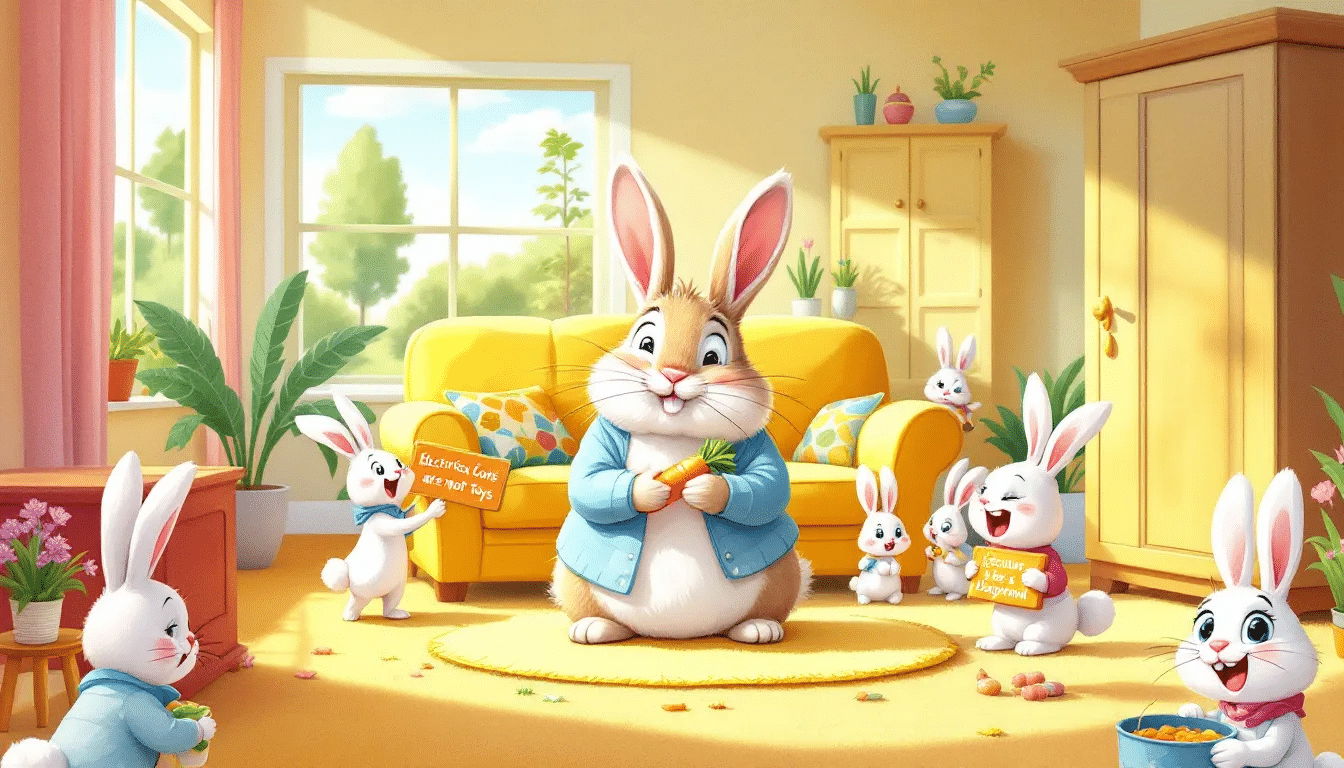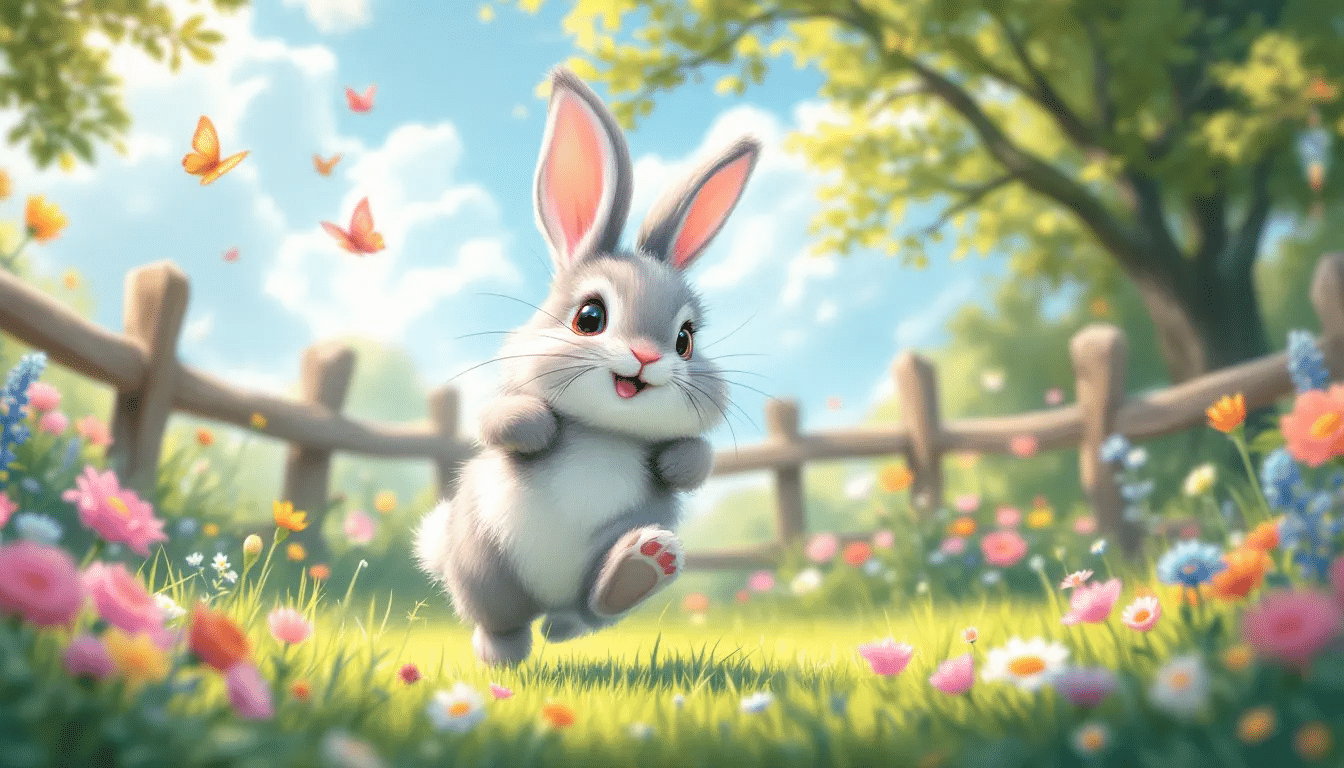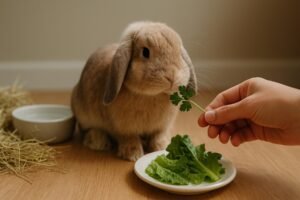Knowing how to take care rabbit involves setting up a safe enclosure, providing the right diet, and ensuring they get enough exercise and mental engagement. This guide covers all the essentials to help you keep your rabbit healthy and happy.
Key Takeaways
- Provide a spacious, safe, and well-ventilated enclosure to support your rabbit’s physical and mental well-being.
- Maintain a balanced rabbit diet consisting primarily of hay, supplemented with fresh vegetables, limited pellets, and occasional fruits to ensure optimal health. Fresh hay should always be available as it is essential for their digestive system and dental health.
- Regular grooming, health monitoring, and understanding rabbit behavior are crucial for building a strong bond and ensuring the well-being of your pet rabbit.
Before Bringing Your Pet Rabbit Home
Before bringing your pet rabbit home, it’s essential to consider whether rabbits are the right pet for you. Rabbits require a long-term commitment, as they can live for 8-12 years. They also need a lot of attention, care, and space to roam. If you’re willing to provide the necessary care and attention, then a pet rabbit can make a wonderful companion.
Are Rabbits the Right Pet for You?
Rabbits are social animals and prefer to live in pairs or groups. However, if you don’t have the space or time to care for multiple rabbits, you can still keep a single rabbit as a pet. Rabbits are intelligent and curious, and they require mental stimulation and enrichment. They also need regular exercise and playtime outside of their enclosure.
If you’re considering getting a pet rabbit, you should also think about your lifestyle and whether it’s compatible with rabbit ownership. For example, if you have young children, you may want to consider whether they are old enough to understand how to handle rabbits gently and safely. You should also consider whether you have enough space in your home for a rabbit enclosure and whether you can provide a safe and stable environment for your pet rabbit.
Preparing Your Home for a Pet Rabbit
Before bringing your pet rabbit home, you’ll need to prepare your home to ensure it’s safe and rabbit-proof. This includes removing any hazardous materials or objects that your rabbit could chew on or ingest. You’ll also need to set up a safe and comfortable enclosure for your rabbit, complete with hiding places, toys, and plenty of fresh hay and water.
You should also consider bunny-proofing your home by blocking off any areas that you don’t want your rabbit to access. This can include using baby gates or pet gates to block off stairs or rooms. You should also secure any loose wires or cords and move any toxic substances out of reach.
Setting Up a Safe and Comfortable Rabbit Enclosure

Creating a suitable home for your pet rabbit begins with selecting the right enclosure. Whether it’s a traditional cage, an exercise pen, or a free-range setup, your rabbit needs ample space to move and engage in natural behaviors. Indoor exercise pens offer a secure area for play and exploration while keeping them safe from hazards. Rabbits need sufficient space to exercise, with a recommended minimum of about 16 square feet for confinement, depending on the number of rabbits.
A rabbit’s enclosure should be at least three hops long and twice as wide as the rabbit to allow ample movement. Space to telescope, stretch out, and run is essential for their physical and mental well-being. A cramped environment can lead to stress and health problems, so prioritize space when setting up your rabbit’s home. Rabbit enclosures should avoid wire bottoms to protect their feet. Solid flooring is recommended to prevent foot injuries and skin infections.
Rabbits prefer safe, concealed spaces with multiple exits, mimicking their natural burrowing instincts.
Rabbits thrive in cool, well-ventilated spaces that are safe from predators and weather extremes. Make sure the enclosure is predator-proof and waterproof to keep your bunny comfortable and secure. Supervise daily exercise outside the enclosure to prevent accidents and encourage healthy activity.
Bunny-Proofing Your Home for House Rabbits

Rabbits are natural chewers, and their inclination to gnaw on anything they find can pose risks both to them and your belongings. Start by creating a designated bunny-proof area using a pen. This manages your rabbit’s space and keeps the rest of the house safe.
Covering electrical cords with durable protectors and securing loose cables with velcro ties or cord organizers can prevent chewing hazards. Bitter apple spray or pure Ivory soap can be applied to furniture and baseboards to deter nibbling. Additionally, using plastic guards, 2x4s, or furring strips can protect baseboards from being chewed.
Safe alternatives for chewing and digging are crucial. A dig box filled with appropriate materials can safely satisfy these natural instincts. Monitor your rabbits’ environment closely after introducing them to a new area to identify potential hazards and make adjustments as needed. This proactive approach ensures your rabbit remains safe and your home stays intact.
Providing a Balanced Diet
A balanced diet is vital for your rabbit’s health and longevity. A rabbit’s diet should primarily consist of hay, making up 80-90% of their food intake. Timothy hay, grass hay, orchard grass, and oat hay provide the necessary fiber for digestive health. Rabbits need a high-fiber diet that consists primarily of unlimited amounts of grass hay. Alfalfa hay is suitable for young rabbits but should be limited for adults due to its richness. Additionally, a diet that encourages chewing helps prevent dental issues by ensuring their teeth are worn down naturally. A healthy rabbit diet also includes unlimited hay, moderate pellets, and limited fresh fruits and vegetables to ensure all nutritional needs are met.
Fresh vegetables are also important for a rabbit’s diet. Introduce them gradually and limit adult rabbits to no more than 2 cups daily to avoid digestive upset. Leafy greens like romaine lettuce are excellent choices, but avoid harmful foods like chocolate, seeds, and certain vegetables. Rabbits should be fed leafy greens such as romaine lettuce, cilantro, and parsley but must not rely solely on these vegetables.
Commercial pellets should be a small part of the diet, with adult rabbits needing just a quarter cup per day. Hydration is equally important. Provide an unlimited supply of fresh water, changed daily to maintain cleanliness and promote drinking. Water should be provided at all times, ideally in a non-tippable bowl for easier access. Rabbits should receive a small amount of high-quality pelleted food once or twice a day, based on their size and activity level.
Fruits can be given sparingly as occasional treats, no more than once or twice a week. Excess fruit should be limited in a rabbit’s diet to prevent gastrointestinal upset due to high carbohydrates. This balanced diet supports your rabbit’s overall health and well-being.
Litter Box Training
Yes, pet rabbits can be toilet-trained! Place a litter box lined with newspaper and hay in the corners where your rabbit naturally tends to go. This setup creates a comfortable toilet area and encourages your rabbit to use the box. Rabbits are naturally clean animals and prefer to go to the bathroom in designated areas. Introducing barriers can help limit your rabbit’s space during training, simplifying the process.
Adding droppings or urine-soaked bedding to the litter tray helps them recognize it as their toilet. Since rabbits tend to eat and relieve themselves simultaneously, placing hay in the litter box can further encourage consistent use. Consistency and patience are key, as it may take time for your rabbit to adapt to new toilet habits.
Maintain a clean and inviting litter box to encourage regular use. Clean the litter box every other day to maintain hygiene and make the area appealing for your rabbit. With persistence and proper setup, your rabbit will soon be using the litter box like a pro.
Ensuring Mental Stimulation and Exercise

Mental stimulation and physical exercise are vital for a rabbit’s well-being. Provide a variety of toys that stimulate their curiosity and instinctual behaviors to keep them engaged and happy. A wide range of toys and activities helps reduce destructive behavior.
Creating a safe space for exercise is crucial. Exercise pens and designated play areas allow your rabbit to move freely and explore, enhancing their physical health and reducing boredom. Environmental enrichment, such as cardboard castles, can serve as both a play area and a quiet retreat.
Incorporate toys, obstacles, and food treats into your rabbit’s environment to mimic natural behaviors and promote well-being. Regular playtime and mental challenges are essential for keeping your rabbit healthy, happy, and well-adjusted.
Regular Grooming and Health Monitoring
Regular grooming is crucial for rabbit care. Here are some important grooming tips:
- Regular nail trimming every 4 to 6 weeks is essential to prevent your rabbit from experiencing discomfort or injury.
- Use appropriate nail clippers and gentle handling to make the process stress-free.
- Brush your rabbit regularly to help remove excess fur and reduce the risk of hairballs, which can lead to serious digestive problems.
Rabbits are a prey species and have a natural instinct to hide signs of illness. This makes careful observation during health checks and environmental management essential to ensure they feel safe and secure in their surroundings.
By following these grooming practices, you can ensure your rabbit stays healthy and comfortable.
For long-haired rabbits, daily grooming is necessary to prevent severe matting and tangling. Routine grooming also helps avoid skin irritations and infections caused by matted fur.
Regular veterinary check-ups are crucial for maintaining your rabbit’s health. Annual vaccinations and full checks help detect and prevent health issues. Monitoring your rabbit’s eating, drinking, and bathroom habits is important for early illness detection. Myxomatosis and calicivirus are fatal diseases to which pet rabbits are vulnerable. Additionally, rabbits are prone to external parasites like mites, fleas, and flies, so regular checks for these issues are essential. However, it is worth noting that vets in training don’t learn enough about rabbit care compared to cats and dogs, so finding a rabbit-savvy vet is particularly important.
If you notice any changes in behavior or signs of a problem, contact a rabbit-savvy vet immediately. Prompt medical attention can significantly affect your rabbit’s health and recovery. Rabbits are very good at hiding signs of illness, so it’s important to be vigilant and act quickly if something seems off.
Preventative Health Care
Preventative health care is essential for keeping your pet rabbit healthy and happy. This includes regular veterinary check-ups, vaccinations, and parasite control. You should also provide your rabbit with a balanced diet that includes plenty of fresh hay, vegetables and limited amounts of pellets.
Regular grooming is also important for your rabbit’s health and well-being. This includes brushing their fur to prevent matting and tangling and trimming their nails to prevent overgrowth. You should also check your rabbit’s teeth regularly to ensure they are healthy and not overgrown.
Understanding Rabbit Behavior

Understanding rabbit behavior is key to building a strong bond with your pet. Rabbits communicate through various body language and vocalizations. For example, a flattened position with the head down and ears flat can indicate fear, while lunging signifies displeasure. Gentle teeth grinding signifies contentment, while loud grinding indicates pain or discomfort. Dental problems among rabbits are common and can lead to serious health issues.
Rabbits also express happiness through behaviors like the binky, a joyful jump with a twist. Thumping or stomping their hind legs communicates danger. Chin rubbing marks territory through scent glands located on their chins. Understanding these behaviors helps you respond appropriately and build a harmonious relationship.
Recognizing and interpreting rabbit emotions is crucial for providing the best care and ensuring your rabbit feels safe and loved. Paying attention to their signals helps create a positive and enriching environment for, your furry friend.
Socialization and Companionship
Rabbits are social animals that thrive in pairs or groups. Most rabbits enjoy grooming and eating together, which fulfills their social needs. Keeping house rabbits alone can lead to stress and loneliness, so companionship is important. Rabbits generally live in environments where they can socialize, and rabbit rabbits can also benefit from having a friend. Rabbits who are raised together tend to bond better than those who are introduced later.
When introducing rabbits to a home environment, especially when other pets like dogs and cats are present, it is crucial to ensure the safety and well-being of the rabbit. Supervision is necessary to facilitate a harmonious coexistence and to mitigate potential stress factors.
Introduce new rabbits gradually and in a neutral space to reduce stress and territorial behavior. Monitor interactions closely to intervene if aggression occurs and start the process over if necessary. Neutering rabbits before bonding can help minimize aggression stemming from hormonal behaviors. Rabbits can be territorial and may fight when they first meet another rabbit. Males will be less likely to fight if introduced at a young age, making early introductions a key strategy for successful bonding.
Positive bonding signs include mutual grooming, resting together, and eating side by side. Once bonded, rabbits should always be housed together to ensure their emotional well-being. Social interaction and companionship are essential for keeping your rabbits happy and healthy.
Integrating with Other Pets
If you have other pets in your home, you’ll need to consider how to integrate your new pet rabbit with them. This can be a challenging process, especially if you have dogs or cats that may see your rabbit as prey. However, with patience and careful introduction, it’s possible to integrate your rabbit with other pets.
You should start by keeping your rabbit and other pets separated and allowing them to get used to each other’s scents and sounds. You can then start to introduce them to each other under close supervision, starting with short introductions and gradually increasing the amount of time they spend together.
It’s also important to remember that rabbits are prey animals and may be naturally fearful of other pets. You should provide your rabbit with a safe and secure enclosure where they can retreat if they feel threatened or scared. With patience and careful introduction, it’s possible to create a harmonious and happy home for all your pets.
Handling Rabbits Safely

Handling rabbits safely is crucial for their well-being. Hold rabbits securely against your body with all four feet supported to help them feel safe. Keep rabbits on their feet while handling them to avoid inducing panic or distress. Supporting the body fully, especially the hind end, when lifting a rabbit can prevent injury. Desexing rabbits can facilitate easier bonding between them.
Approach rabbits slowly and calmly to avoid startling them. Supervise children closely when they interact with rabbits to ensure safe handling practices. Avoid lifting rabbits by their ears, as this can cause significant stress and potential harm.
Restrict movement only as necessary during handling to minimize stress for the rabbit. Safe and gentle handling helps build trust and ensures your rabbit feels comfortable and secure.
Seasonal Care Considerations
Caring for rabbits requires attention to seasonal changes. In cold weather, rabbits can tolerate it better than heat, but extreme cold can lead to hypothermia and frostbite. Winterize a rabbit’s hutch by elevating it off the ground and sealing gaps to block drafts. Providing proper bedding, such as fresh straw or hay, adds additional warmth and comfort. Rabbits can live for up to 12 years with proper care.
Monitoring rabbits for health issues is especially important in winter, when they may show less activity. In hot weather, regularly check for heat stress, as temperatures exceeding 28°C can endanger their health. Ensure your rabbit stays cool with plenty of fresh water and shade to prevent heat-related health issues.
Adapting your care routine to seasonal changes ensures your rabbit remains healthy and comfortable throughout the year. Proactive seasonal care can prevent health problems and keep your rabbit thriving.
Summary
In summary, taking care of a pet rabbit involves creating a safe and comfortable enclosure, bunny-proofing your home, providing a balanced diet, and much more. Regular grooming, understanding rabbit behavior, and ensuring socialization and companionship are also crucial aspects of rabbit care. Handling rabbits safely and adapting to seasonal changes further contribute to their well-being.
By following this guide, you can provide the best possible care for your rabbit, ensuring they live a happy, healthy, and fulfilling life. Remember, a well-cared-for rabbit is a joyful companion that brings endless delight to your home.
Frequently Asked Questions
What type of Timothy hay is best for my rabbit?
Timothy hay is the best choice for your rabbit, along with orchard grass and oat hay, as they supply essential fiber for optimal digestive health.
How often should I groom my rabbit?
Groom your rabbit regularly, trimming their nails every 4-6 weeks and brushing them frequently to prevent matting and hairballs. This will help keep your rabbit healthy and comfortable.
Can rabbits be litter-trained?
Yes, rabbits can be litter-trained by placing a litter box lined with newspaper and hay in their preferred corners. This encourages them to use the box consistently.
How do I introduce a new rabbit to my existing rabbit?
To successfully introduce a new rabbit to your existing rabbit, do so gradually and in a neutral space to minimize territorial issues. Always monitor their interactions closely and be prepared to separate them if any signs of aggression arise.
What should I do if my rabbit shows signs of illness?
If your rabbit shows signs of illness, it’s crucial to contact a rabbit-savvy vet immediately, as prompt medical attention can significantly impact its health and recovery. Don’t hesitate—your rabbit’s well-being depends on it.



